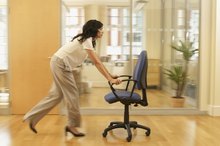What Are the Causes of Back Pain When Working on the Computer?
Your spinal column consists of bones called vertebrae that protect the bundle of nerves called the spinal cord. Separated by gelatinous cushions called discs, the vertebrae stretch from the cervical or neck region to the base of your spine, called the lumbar area. Various conditions, injuries and repetitive stresses can damage these delicate structures, including sitting in a chair working on a computer for several hours a day. Back pain from computer use is related to a number of internal and external factors.
If you are experiencing serious medical symptoms, seek emergency treatment immediately.
Risk Factors
The risk of developing back pain is higher for some people than for others. Risk factors that you cannot change include spinal deformities such as scoliosis; conditions such as osteoporosis; and being a woman, according to a 2012 report published in "BMC Musculoskeletal Disorders." Modifiable risk factors include:
- the type of work you do
- how long it takes
- your workstation design
- your posture
- the intensity of your work
- other changeable parameters
Because of the number of individual variations, it can be difficult to determine a cause-and-effect relationship between back pain and computer use in a particular person.
Uncomfortable Chairs
How to Sit with Pinched Nerve Syndrome
Learn More
If you experience back pain while using the computer, your chair may be contributing to the problem if it does not support your body properly. Poor body alignment for long periods can cause pressure on various areas of your spine and contribute to pain in your back, neck, shoulders and arms. Choosing a chair that can be adjusted to your body seems to assist in relieving back pain, although the evidence of a cause-and-effect relationship is modest. Important features include the ability to adjust the backrest, armrests and the height of the chair. A curved versus a flat seat may also affect whether your upper or lower back are stressed with prolonged sitting.
- If you experience back pain while using the computer, your chair may be contributing to the problem if it does not support your body properly.
Poor Posture
Even the perfect office chair will not help your back if you sit with a slumped posture for long periods. Your spine is designed to be in an upright, neutral position with your shoulders back and a slight curvature at the base. Leaning forward to reach the keyboard, twisting your body while talking on the telephone, dangling your feet off a too-high chair or bending your head to see the computer screen takes your back out of a neutral posture. The height of your computer and desk should be adjusted so you can look straight at the screen rather than leaning forward.
- Even the perfect office chair will not help your back if you sit with a slumped posture for long periods.
- The height of your computer and desk should be adjusted so you can look straight at the screen rather than leaning forward.
Inactivity
How to Eliminate Back Pain From Walking on Concrete Floors
Learn More
Sitting in any position for more than 20 minutes can contribute to back pain by reducing the flexibility of your tendons and ligaments over time. To prevent back pain at work, shift your position often and take brief breaks every 20 minutes 3. Standing and leaning back with your hands behind the small of your back can help to improve your spine flexibility and prevent pain while working at the computer.
- Sitting in any position for more than 20 minutes can contribute to back pain by reducing the flexibility of your tendons and ligaments over time.
- Standing and leaning back with your hands behind the small of your back can help to improve your spine flexibility and prevent pain while working at the computer.
Related Articles
References
- BMC Musculoskeletal Disorders: The Effectiveness of a Chair Intervention in the Workplace to Reduce Musculoskeletal Symptoms -- A Systematic Review
- Spine-Health: Office Chair, Posture and Driving Ergonomics
- AAOS: Preventing Back Pain at Work and at Home
- Journal of Craniovertebral Junction and Spine: Management of Low Back Pain in Computer Users -- A Multidisciplinary Approach
- Spine-Health: Work Ergonomics -- Minimize Back Injuries
- Noormohammadpour P, Mansournia MA, Koohpayehzadeh J, et al. Prevalence of Chronic Neck Pain, Low Back Pain, and Knee Pain and Their Related Factors in Community-Dwelling Adults in Iran: A Population-based National Study. Clin J Pain. 2017;33(2):181-187. doi:10.1097/AJP.0000000000000396
- Wong AY, Karppinen J, Samartzis D. Low back pain in older adults: risk factors, management options and future directions. Scoliosis Spinal Disord. 2017;12:14. doi:10.1186/s13013-017-0121-3
- Janwantanakul P, Pensri P, Moolkay P, Jiamjarasrangsi W. Development of a risk score for low back pain in office workers--a cross-sectional study. BMC Musculoskelet Disord. 2011;12:23. doi:10.1186/1471-2474-12-23
- Shipton EA. Physical Therapy Approaches in the Treatment of Low Back Pain. Pain Ther. 2018;7(2):127-137. doi:10.1007/s40122-018-0105-x
- Peul WC, Bredenoord AL, Jacobs WC. Avoid surgery as first line treatment for non-specific low back pain. BMJ. 2014;349:g4214. doi:10.1136/bmj.g4214
- Abdel Shaheed C. Efficacy, Tolerability, and Dose-Dependent Effects of Opioid Analgesics for Low Back Pain A Systematic Review and Meta-analysis. JAMA Internal Medicine. July 2016. doi:10.1001/jamainternmed.2016.1251
- Deyo RA, Mirza SK, Turner JA, Martin BI. Overtreating Chronic Back Pain: Time to Back Off? J Am Board Fam Med. 2009;22(1):62–68. doi:10.3122/jabfm.2009.01.080102
- Gold R, Esterberg E, Hollombe C, et al. Low Back Imaging When Not Indicated: A Descriptive Cross-System Analysis. Perm J. 2016;20(2):25–33. doi:10.7812/TPP/15-081
- Johansson, Stochkendahl J, Hartvigsen J, Boyle E, Cassidy J. Incidence and Prognosis of Mid-Back Pain in the General Population: A Systematic Review. European Journal of Pain. 2017 Jan;21(1):20-28. doi:10.1002/ejp.884
- Sites BD, Beach ML, Davis MA. Increases in the Use of Prescription Opioid Analgesics and the Lack of Improvement in Disability Metrics Among Users. Reg Anesth Pain Med. 2014;39(1):6–12. doi:10.1097/AAP.0000000000000022
Writer Bio
Marcy Brinkley has been writing professionally since 2007. Her work has appeared in "Chicken Soup for the Soul," "Texas Health Law Reporter" and the "State Bar of Texas Health Law Section Report." Her degrees include a Bachelor of Science in Nursing; a Master of Business Administration; and a Doctor of Jurisprudence.









